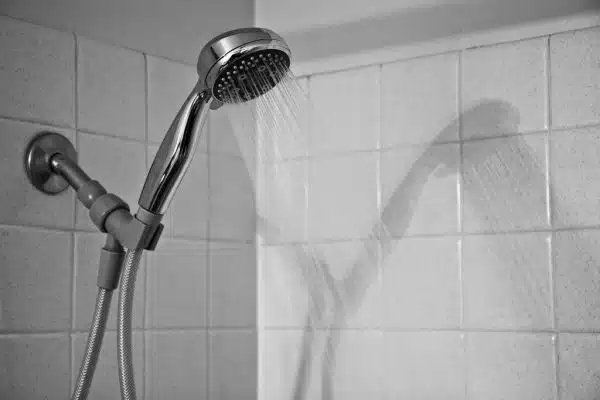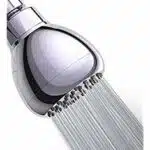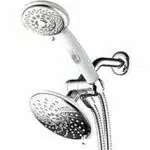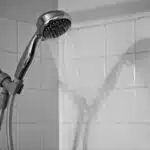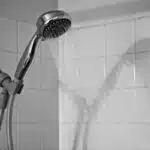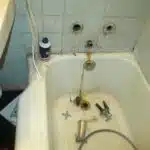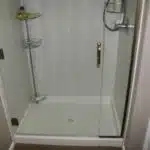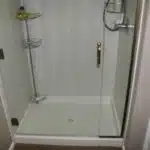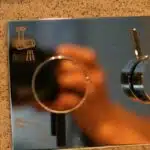Showerheads are a crucial component of our daily lives, and they play a vital role in ensuring our hygiene. A clean and functional showerhead can make all the difference in your showering experience, providing you with an invigorating and refreshing bathing experience. However, over time, showerheads can accumulate grime, dirt, and mineral deposits that can affect their performance and even pose health hazards. Therefore, it is essential to know how to clean your showerhead properly.
Cleaning your showerhead may seem like a daunting task; however, with the right tools and technique, it is a straightforward process that can be done in no time. Regular cleaning of your showerhead not only ensures its longevity but also helps maintain its optimal performance. Moreover, a clean showerhead prevents bacterial growth that could lead to skin irritation or other health issues. In this article, we will provide you with some tips on how to clean your showerhead effectively using simple household items that are readily available.
Understanding The Importance Of Showerhead Cleaning
Maintaining a clean showerhead is essential to ensuring that you have the best possible shower experience. A well-maintained showerhead has long term benefits that can impact both your health and your wallet. The importance of maintenance cannot be overstated, as a dirty showerhead can lead to various problems.
One of the long term effects of an unclean showerhead is reduced water pressure. Over time, mineral deposits can accumulate in the small holes of the showerhead. This buildup can cause water to spray unevenly or even stop flowing altogether. Reduced water pressure not only makes for an unpleasant shower experience but also wastes water and increases energy consumption as you may need to spend more time in the shower trying to rinse off soap suds.
Another negative impact of an unclean showerhead is potential health hazards. Bacteria and other harmful microorganisms can accumulate in the moist environment of a dirty showerhead and be dispersed into the air when you take a shower. Inhaling these particles can lead to respiratory problems, especially for those with pre-existing conditions like asthma or allergies. Thus, it is crucial to maintain a clean and sanitary environment in your bathroom by regularly cleaning your showerhead.
A clean and well-maintained showerhead guarantees a refreshing and hygienic start to your day. However, before we delve into how you should go about cleaning your showerhead, let us first discuss some signs that indicate that it needs cleaning.
Signs Your Showerhead Needs Cleaning
Did you know that the average showerhead has more bacteria than a toilet seat? According to a study conducted by NSF International, showerheads are hotspots for bacteria growth due to the warm and moist environment they provide. This can lead to harmful infections and diseases, especially for those with weakened immune systems. It is essential to keep your showerhead clean to avoid these health risks.
Common causes of a dirty showerhead include hard water buildup, mineral deposits, and mold growth. Hard water contains high levels of minerals such as calcium and magnesium, which can leave behind residue on your fixtures over time. Mineral deposits can clog the small holes in your showerhead, causing low water pressure. Mold thrives in damp environments like your bathroom and can quickly grow on your showerhead if not cleaned regularly.
To prevent a dirty showerhead, consider using a water softener or installing a filtration system to reduce hard water buildup. Regularly cleaning your bathroom and wiping down surfaces after each use can also help prevent mold growth. Additionally, try removing your showerhead once every few months to soak it in vinegar or another cleaning solution specifically designed for removing mineral deposits.
Now that you know the signs of when your showerhead needs cleaning and how to prevent it from getting dirty in the first place, it’s time to gather the necessary tools and materials to get started on deep-cleaning your fixture.
Gather The Necessary Tools And Materials
To clean your showerhead effectively, you will need to gather the necessary tools and materials. The first step is to identify the best materials needed for the job. You can use store-bought cleaning solutions or DIY alternatives that are readily available in your home.
Here are some of the best materials and tools that you will need:
- A plastic bag
- White vinegar
- A toothbrush or scrub brush
- A wrench (if necessary)
- Water
Before you start cleaning, ensure that you have all these items ready. It is essential to choose the right cleaning solution for your showerhead. Store-bought cleaning solutions are perfect for those who want quick results without much effort. However, if you prefer a more natural approach, then DIY alternatives like baking soda and vinegar may be your best bet.
When choosing a cleaning solution, consider the material of your showerhead. Some materials like brass or gold-plated showerheads require gentle cleaners to avoid damaging them. Remember that using harsh chemicals may cause discoloration or damage to some types of showerheads. With all the necessary tools and materials ready, let’s dive into how to remove and disassemble your showerhead for thorough cleaning.
Removing And Disassembling The Showerhead
To begin the process of cleaning your showerhead, you need to remove it from its position. This is a necessary step because it allows you access to all the parts that need to be cleaned. To do this, start by turning off the water supply. Depending on your showerhead type, you can either unscrew it using an adjustable wrench or twist it off with your hands.
After removing the showerhead, disassemble it by taking out all its detachable components. These may include the faceplate, aerator, and rubber gasket. Be sure to keep all the parts in a safe place so that they don’t get lost during cleaning or reassembly. Inspect these parts carefully for any signs of damage or wear and tear.
Once you have removed and disassembled your showerhead, you are now ready to proceed with cleaning it thoroughly. Before doing so, ensure that you have readied all the necessary equipment such as vinegar solution, brushes, and rags. With these items in hand, move on to soaking your showerhead in a cleaning solution for effective cleansing of its various parts.
Transition: Now that we have successfully removed and disassembled our showerhead components let’s move onto soaking them in a cleaning solution for further cleansing and maintenance.
Soaking The Showerhead In A Cleaning Solution
Imagine a world without regular cleaning. The dirt and grime would accumulate, making our surroundings unpleasant and unhygienic. Similarly, an unclean showerhead can lead to a buildup of bacteria and mineral deposits. This not only affects the quality of water but also reduces the water pressure. Hence it is crucial to clean your showerhead regularly.
One effective way to clean your showerhead is by soaking it in a cleaning solution. There are several benefits to this method, including its effectiveness and duration. Soaking the showerhead in a cleaning solution ensures that all the nooks and crannies are cleaned thoroughly. The solution dissolves any mineral buildup or bacteria, leaving the showerhead sparkling clean. Additionally, this method takes minimal effort as you can leave the showerhead immersed in the cleaning solution for a few hours or overnight.
Despite its effectiveness, there are some risks associated with soaking your showerhead in a cleaning solution. If you use a harsh chemical-based cleaner, it may cause damage to the rubber gaskets or plastic parts of your showerhead. To avoid this, ensure that you use a cleaning solution that is specifically designed for showers or make your own using natural ingredients such as vinegar or baking soda.
Now that you know about soaking your showerhead let’s move on to another essential step – cleaning the nozzles! By doing so, you can ensure that water flows through them efficiently and effectively cleanses you during your refreshing showers!
Cleaning The Showerhead Nozzles
- Vinegar is an effective and natural way to help clean and unclog showerhead nozzles.
- An old toothbrush can be used to scrub away stubborn deposits on the nozzles.
- Mineral build up can be the most difficult to remove, but it can be done by soaking the nozzles in a vinegar and water solution.
- After the nozzles have soaked, they should be brushed with an old toothbrush to remove remaining deposits.
- Some mineral build-up can be so deep-rooted that it needs to be removed with a special tool.
- Following these steps will help to ensure that the showerhead nozzles are clean and free from any mineral build-up.
Cleaning With Vinegar
Are you tired of a clogged showerhead? One of the most effective ways to clean your showerhead is by using vinegar. Vinegar has natural acidic properties that can dissolve mineral buildup, which is one of the main causes of clogging. To begin, remove the showerhead from its fixture and place it in a plastic bag filled with vinegar. Let it soak for at least an hour or overnight for tougher stains. Afterward, rinse it in warm water and scrub off any remaining buildup with an old toothbrush.
If you prefer not to use vinegar, there are other natural cleaning solutions available that work just as well. For instance, baking soda mixed with water can create a paste that can be applied to the showerhead nozzle and left for 30 minutes before rinsing it off with warm water. Alternatively, lemon juice can be used as a natural cleaner due to its citric acid properties. Squeeze some lemon juice on the showerhead nozzle and let it sit for 30 minutes before rinsing it off.
In conclusion, cleaning your showerhead nozzles doesn’t have to involve harsh chemicals or expensive products. Using vinegar or alternative natural cleaning solutions such as baking soda or lemon juice can provide effective results without damaging your plumbing fixtures. By regularly maintaining your showerhead with these methods, you can ensure a steady flow of water and a refreshing shower experience every time.
Scrubbing With An Old Toothbrush
When it comes to cleaning your showerhead nozzles, there are various natural cleaning solutions available that can help eliminate mineral buildup and keep your plumbing fixtures functioning properly. One of the most effective ways to clean showerheads is by using a vinegar solution, which has natural acidic properties that can dissolve mineral buildup. However, if you prefer not to use vinegar, there are other alternatives such as baking soda and lemon juice that can provide equally effective results.
Once you have soaked your showerhead in a vinegar solution or applied a natural cleaning paste mixture, it’s time to start scrubbing off any remaining buildup with an old toothbrush. Gently scrub the nozzle holes and all around the edges of the showerhead until all visible dirt and debris have been removed. This process may take some time, but it’s crucial for ensuring that your showerhead is thoroughly cleaned.
If scrubbing with an old toothbrush does not effectively remove the buildup on your showerhead or if it is old and beyond repair, then you may need to consider replacing the entire fixture altogether. Replacing a showerhead is relatively easy and can be done without calling in a professional plumber. By following these simple steps for cleaning and maintaining your showerhead nozzles or replacing them when necessary, you can ensure that your bathroom stays clean and functional for years to come.
Removing Mineral Build-Up
To maintain the functionality of your showerhead, it is crucial to remove mineral buildup regularly. Mineral buildup happens when hard water deposits minerals like calcium and magnesium on showerhead nozzles, causing them to clog and reducing water pressure. Fortunately, there are effective cleaning solutions you can use to eliminate mineral buildup on your showerhead.
One of the most effective ways to remove mineral buildup from a showerhead is by using vinegar. Vinegar has natural acidic properties that dissolve mineral buildup effectively without damaging the fixture’s quality. To use vinegar as a cleaning solution for your showerhead, mix equal parts of white vinegar and water in a plastic bag and tie it around your showerhead nozzle with a rubber band. Leave it for an hour before removing it and rinsing off any remaining debris.
If you prefer not to use vinegar, you can also try other natural cleaning alternatives like baking soda or lemon juice. Baking soda works well as an abrasive agent that helps scrub away stubborn mineral deposits, while lemon juice’s citric acid dissolves minerals naturally. To use baking soda or lemon juice as cleaning solutions for your showerhead, create a paste by mixing either one with water until it becomes thick enough to apply easily on the nozzle holes and edges of your fixture. Scrub gently with an old toothbrush before rinsing off with water.
Scrubbing The Showerhead With A Toothbrush
After cleaning the showerhead nozzles, it’s time to get rid of the remaining grime and dirt by scrubbing the showerhead with a toothbrush. However, if you don’t have a spare toothbrush, there are other alternatives that you can use.
One alternative to using a toothbrush is to make use of an old dish brush or any other stiff-bristled brush that can fit into the showerhead holes. Alternatively, you can create your own scrubbing tool by tying a cloth around a chopstick or skewer and using it to clean each nozzle.
When scrubbing your showerhead, be sure to use eco-friendly cleaning solutions such as vinegar and baking soda mixtures. These natural ingredients will not only help remove any buildup but also disinfect your showerhead without harming the environment or your health.
With these alternatives and eco-friendly solutions in mind, you can now proceed to scrubbing your showerhead with ease. Once done, rinse it thoroughly with water before drying it off completely. This will prevent any mineral buildup from forming on the surface and ensure that your showerhead remains clean for longer periods.
Rinsing And Drying The Showerhead
After scrubbing your showerhead with a cleaning solution, the next step is to rinse it thoroughly. This is important as any remaining cleaning solution can cause damage to the metal and plastic components of the showerhead. To ensure effective rinsing, remove any detachable parts of the showerhead and run hot water through them for at least 30 seconds.
For non-detachable showerheads, use a cloth or sponge to remove any residue from the surface before running hot water over it. Be sure to cover all surfaces of the showerhead, including nozzles, with clean water to remove any remaining dirt or debris. Repeat this process until you are confident that everything has been washed away.
Once you have finished rinsing your showerhead, it’s time to air dry it. While some people prefer to wipe down their showerheads with a towel after washing them, air drying is actually more beneficial. By allowing your showerhead to air dry naturally, you reduce the risk of bacterial growth caused by moisture buildup in cloth or towels. Plus, letting it dry on its own ensures that there are no leftover droplets that can cause mineral buildup or rust over time.
As you finish up this step of cleaning your showerhead, remember that proper rinsing and drying will help extend its lifespan and keep it functioning properly for years to come. With these tips in mind, let’s move on to reassembling the showerhead so that you can get back to enjoying a refreshing and clean shower experience once again.
Reassembling The Showerhead
After rinsing and drying your showerhead, it’s time to put the pieces back together. Did you know that reassembling the showerhead is just as important as cleaning it? According to a survey conducted by HomeAdvisor, 50% of homeowners experience low water pressure due to poorly assembled showerheads.
To prevent this common issue, follow these reassembling techniques:
- Refer to your showerhead manual for specific instructions and diagrams.
- Use Teflon tape on the threads of each piece to create a tight seal.
- Hand tighten each piece before using pliers or a wrench.
Common mistakes when reassembling a showerhead include over-tightening, cross-threading, and forgetting to use Teflon tape. These mistakes can result in leaks, cracks, and low water pressure. It’s important to take your time and follow the proper steps for reassembly.
Once you’ve successfully put everything back together, it’s time to test the showerhead’s water flow. Turn on the water and check for any leaks or dripping from the connections. Then, assess the level of water pressure. If there are still issues with low water pressure, consider consulting a professional plumber or replacing your showerhead altogether.
Testing The Showerhead’s Water Flow
After cleaning your showerhead, it is important to test the water flow to ensure that it is working properly. Measuring pressure is a key step in determining if there are any issues with the showerhead. One way to do this is to use a pressure gauge, which can be purchased at most hardware stores. Simply attach the gauge to your showerhead and turn on the water to see the pressure reading.
If the pressure reading is low, there may be an issue with your plumbing system or a clog in the showerhead. Troubleshooting leaks can also help identify any problems with water flow. Check for any visible signs of leaks such as dripping water or moisture around the base of the showerhead. If you find any leaks, tighten any loose connections or replace damaged parts as necessary.
By testing your showerhead’s water flow and troubleshooting leaks, you can ensure that it is functioning properly and providing you with a satisfying shower experience. However, if you notice stubborn buildup on your showerhead after cleaning, there are alternative cleaning methods available. These methods can help remove even tough mineral deposits and grime buildup from your showerhead for optimal performance and cleanliness.
Alternative Cleaning Methods For Stubborn Buildup
After testing the water flow of your showerhead, you may have noticed a decrease in pressure due to mineral buildup. While using vinegar solutions and abrasive cleaners are effective methods for cleaning the showerhead, there are alternative cleaning methods for stubborn buildup.
One method is to use a toothbrush or small brush to scrub away any visible residue on the surface of the showerhead. This can be done with or without a cleaning solution, depending on the severity of the buildup. Another option is to use a combination of baking soda and water to create a paste, which can be applied directly onto the showerhead and left to sit for several minutes before rinsing off.
It’s important to note that these alternative methods should only be used if traditional cleaning methods do not work. If you have tried vinegar solutions and abrasive cleaners with no luck, then consider trying one of these alternative methods. Additionally, it’s crucial to take preventative measures in order to avoid mineral buildup in the future.
- Regularly clean your showerhead using vinegar solutions or abrasive cleaners.
- Use a water softener if you live in an area with hard water.
- Consider installing a shower filter specifically designed to remove minerals from the water.
- Wipe down your showerhead after each use to prevent any residual moisture from accumulating and promoting mineral buildup.
By taking preventative measures and utilizing alternative cleaning methods when necessary, you can keep your showerhead free of mineral buildup and maintain optimal water flow for a refreshing shower experience.
Preventing Mineral Buildup In The Future
Preventing corrosion is crucial in keeping your showerhead clean and functioning well. One way to do this is by installing a water softener. Water softeners remove minerals that can cause buildup and corrosion in pipes and fixtures. Another option is to use a filter for your showerhead. This will also remove minerals and other impurities from the water, preventing them from accumulating on your showerhead.
In addition to preventing corrosion, using natural cleaning solutions can help keep your showerhead clean without harsh chemicals. A simple solution of vinegar and water can be used to soak the showerhead overnight, breaking down any mineral buildup. Lemon juice or baking soda can also be effective natural cleaners for removing buildup. It’s important to use caution when using natural cleaners, however, as some may react with certain materials or cause damage if left on too long.
Regular maintenance of your showerhead is key in preventing mineral buildup and ensuring its longevity. Cleaning your showerhead on a regular basis not only keeps it looking nice but also helps maintain proper water pressure and reduces the risk of leaks. By incorporating preventative measures like installing a water softener or filter and using natural cleaning solutions, you can keep your showerhead in top shape for years to come.
Cleaning Your Showerhead On A Regular Basis
To prevent mineral buildup in the future, it is important to regularly clean your showerhead. This task should be done frequently, depending on the hardness of your water. Harder water will cause more buildup and require more frequent cleaning. Neglecting to clean your showerhead can lead to clogs, reduced water pressure, and even bacterial growth.
When it comes to cleaning products for your showerhead, there are several options available. Commercial descaling solutions can be effective but may contain harsh chemicals that could damage your showerhead or harm the environment. DIY solutions using common household items such as vinegar or lemon juice can also do the job without putting your health or the environment at risk.
To clean your showerhead with a DIY solution, first remove the showerhead from its fixture and place it in a bowl filled with the cleaning solution. Let it soak for several hours before rinsing thoroughly with water and reattaching it to its fixture. As an alternative method, you could fill a plastic bag with the cleaning solution and attach it over the showerhead using a rubber band, leaving it in place for several hours before rinsing.
- Use a toothbrush or soft brush to scrub any stubborn buildup
- Consider installing a water softener system if you have particularly hard water
- Regularly replace your showerhead if buildup becomes too severe
- Cover your showerhead with a plastic bag filled with vinegar overnight for an extra deep clean
By making regular cleaning of your showerhead part of your household maintenance routine, you can ensure a comfortable and hygienic bathing experience. Other tips for a clean and comfortable showering experience include proper ventilation in bathrooms, using bath mats to prevent slips and falls, and regularly washing towels and bathrobes.
Other Tips For A Clean And Comfortable Showering Experience
Keeping your showerhead clean is an important part of maintaining a comfortable and relaxing showering experience. However, there are other factors to consider beyond just cleaning the showerhead itself. In this section, we will discuss two additional tips for improving your overall shower experience.
Firstly, aromatherapy can be a great addition to any shower routine. By adding essential oils or scented shower gels to your shower, you can create a calming and rejuvenating atmosphere that can help reduce stress and promote relaxation. Some popular scents for aromatherapy in the shower include lavender, eucalyptus, and peppermint. Be sure to research how to safely incorporate essential oils into your routine before trying it out.
Secondly, choosing the right showerhead filter can also make a big difference in your overall experience. Filters can help remove impurities from the water such as chlorine or heavy metals that can dry out skin and hair. Additionally, some filters can even help increase water pressure for a more invigorating shower experience. Do some research on different types of filters available and choose one that fits your specific needs.
In conclusion, by incorporating aromatherapy and choosing the right filter for your showerhead, you can greatly improve the overall comfort and relaxation of your daily showers. These small additions may seem insignificant but they can have a big impact on your well-being over time. Now let’s move onto our final thoughts on keeping your showerhead clean.
Final Thoughts On Showerhead Cleaning
After following the tips and steps outlined above, you should have a clean showerhead that is free of mineral buildup and other debris. However, it is important to note that maintaining cleanliness in your showerhead requires ongoing effort. One of the ways to maintain cleanliness is by regularly cleaning your showerhead every few months or as needed.
Another way to maintain cleanliness is by using effective cleaning solutions. While vinegar and baking soda are popular options, there are also commercial products available specifically designed for cleaning showerheads. Be sure to read the labels carefully and follow the instructions provided by the manufacturer.
Overall, keeping your showerhead clean not only helps improve water flow but also ensures that you are not exposed to harmful bacteria or chemicals. By incorporating regular maintenance into your household routine, you can enjoy a refreshing and hygienic shower experience every time without worrying about any unwanted particles lurking in your showerhead.
Conclusion
Maintaining a clean showerhead is essential for a comfortable and hygienic showering experience. Signs that your showerhead needs cleaning include reduced water pressure, strange odors, and visible mineral buildup. To properly clean your showerhead, you will need tools such as pliers and a cleaning solution that removes mineral deposits. After disassembling the showerhead, soaking it in the solution for several hours will help to remove any buildup.
To prevent mineral buildup in the future, consider installing a water softener or using distilled water for your showers. Cleaning the showerhead regularly can also help prevent buildup and improve overall water flow. Don’t forget to clean other parts of your shower as well, including the walls and floor.
In conclusion, keeping your showerhead clean is important for both hygiene and comfort. By following these steps and tips for regular maintenance, you can enjoy a refreshing shower without worrying about mineral buildup or decreased water pressure. As the old saying goes, “cleanliness is next to godliness,” so make sure to prioritize maintaining a clean bathroom environment for yourself and your loved ones.
Image Credits
- “showerhead” by gfairchild (featured)

